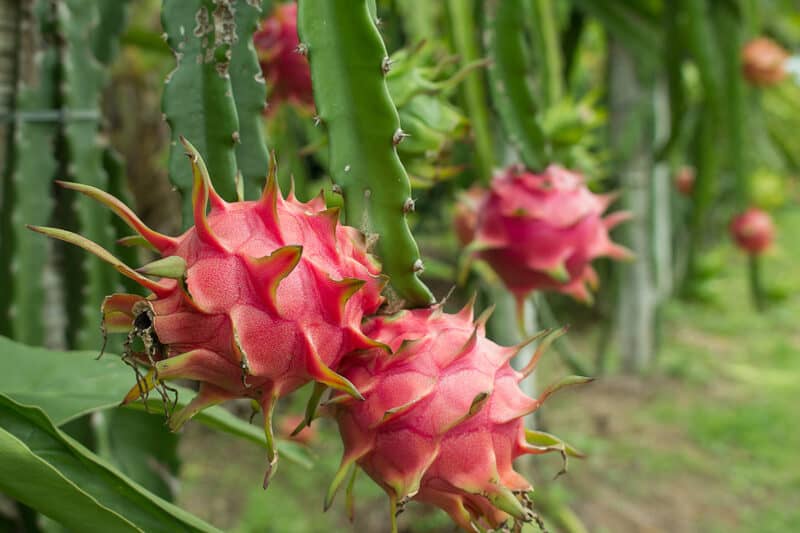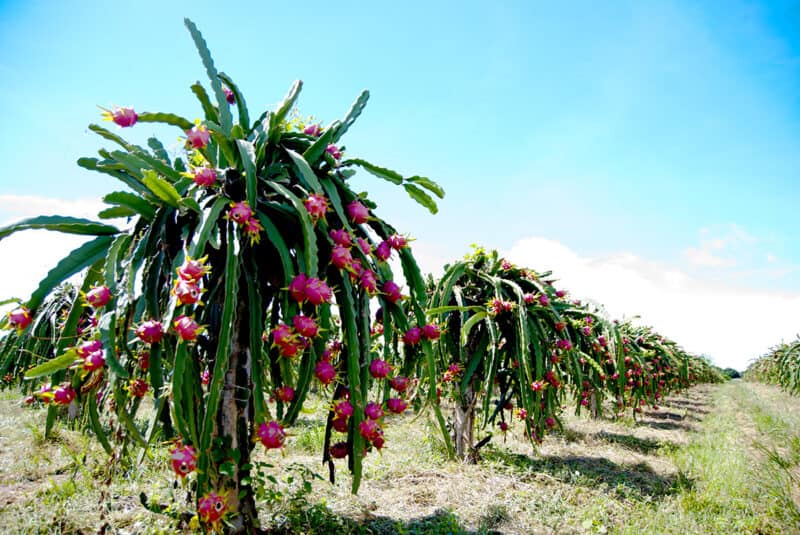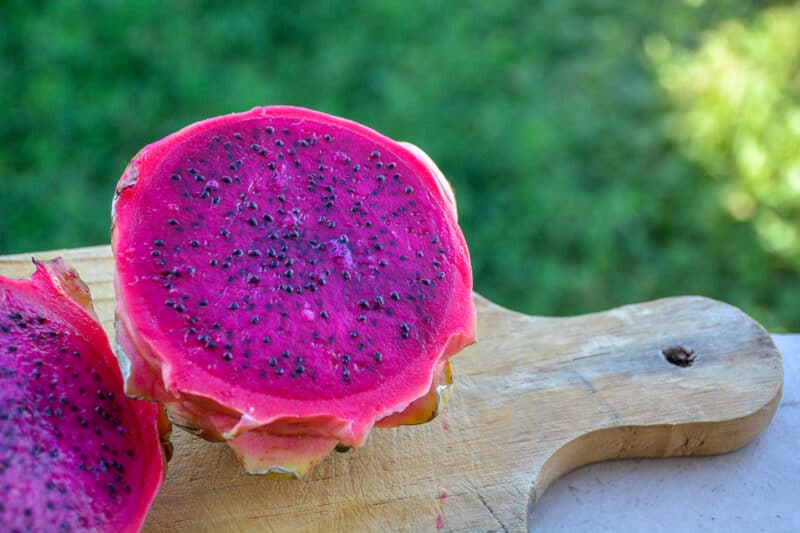Is It Easy to Grow Dragon Fruit
Dragon fruits are a wonderfully tasty fruit that you'll be eager to start growing yourself once you try it.
You may have seen dragon fruit in the store and wondered what the heck it was or how to use it. It's an odd-looking fruit that looks like a spiky, pinkish-red baseball.
The cactus-type plant does well in dry, warm climates, and it doesn't require much in the way of care, except for lots of heat and a little water.
If you want to add the intriguing dragon fruit to your home garden, we'll show you all you need to know.
What is Dragon Fruit?
Dragon fruit (Selenicereus undatus) is a cactus that grows in South America, Central America, and Asia. You might also see it called pitahaya, pitaya, Belle of the Night, Cactus fruit, Kaktus madu, or Thanh Long.

Grown in South East Asia and the Caribbean, it has become established in warm North American places like Southern California, Texas, and Florida.
Some people grow them as ornamentals in the garden, partially because they have some of the largest blossoms in the world.
But the fruit is so delicious that there's no reason not to use it. It starts as green and gradually turns yellow or red, depending on the variety.
They grow fast, too, which makes them particularly appealing for people who need a quick pop of interest in their garden – or a fruit they can start munching on without waiting decades.
Varieties of Dragon Fruit
There are a lot of varieties of dragon fruit out there, including a lot of hybrids. I'm going to concentrate on those that are the best to grow at home and have the best flavor.
Although a relatively unknown plant in some areas, it's available from more and more plant suppliers.
Yellow Dragon Fruit
This super sweet variety is my favorite of the dragon fruits for home growing. It's small to medium in size when mature, and it self pollinates and sets fruit all on its own.
Zamorano
Originally from Honduras, 'Zamorano' fruits are a deep red color and the plant sets fruit on its own. One of the most versatile dragon fruits, it can be eaten fresh and is also wonderful juiced.
Vietnamese Jaina
This variety has pink to deep red skin, contrasting with snow-white flesh dappled with little black seeds. Dragon fruit is one of Vietnam's most commonly exported fruits, and it's easy to see why with this self pollinator.
Thompson
This big Californian variety is self-pollinating and the fruit has been known to weigh up to 1.5 pounds. It has a thick skin that separates from the sweet flesh easily.
Physical Graffiti
This hybrid was created from white and red varieties and is a reliable option that pollinates and sets fruit on its own. The fruit is quite large and a real looker, with pinkish-red skin and purple flesh dotted with tiny seeds.
Neitzel
Another larger fruit with white flesh that can weigh up to 1 pound. Neitzel is a sweet delight chilled in the fridge, cut in half, and eaten with a spoon.
Other varieties of self-pollinating types include:
- Makisupa
- Lake Atitlan
- Guyute
- Voodoo Child
- American Beauty
How to Plant Dragon Fruits
Growing dragon fruits outdoors year-round is possible in USDA Zones 9-12. In cooler areas, grow dragon fruit in pots and move them inside in the winter. Grow it as a patio specimen in Zones 4-12.
For the best harvest, temperatures between 65°F and 85°F are optimal. Temperatures under 32°F will kill your dragon fruit unless you offer it some protection.
Dragon fruit trees love the sun but can withstand a little shade around the root area. As long as the foliage gets sun for most of the day, the plant should be happy. Sunlight for 6 to 8 hours is best.
Remember, this is a cactus that comes from sunny, warm regions.
Speaking of the kind of environments cacti love, sandy soil that drains well is important. Soil that allows water to pool or that retains water for too long will absolutely kill your plant.
While it isn't as vital as drainage, aim for a pH of 6.0 to 7.0.
When planting dragon fruits in the ground, space the plants out with six feet between every tree and nine feet between rows.
In the home garden, you can reduce this distance and control the tree's growth by cutting and shaping.
When to Plant
If you live in a warm area, early spring is a good time to plant dragon fruit, but you can put it in the ground anytime.
However, if you're growing it in an area that experiences frost, wait until the risk of frost passes. The temperature average should be higher than 65°F.
Planting Seed
Planting dragon fruit seed is reasonably successful, but sometimes germination rates can be hit and miss. It takes up to seven years from seed to your first fruit harvest.
Sprinkle a few seeds on the surface of good quality, well-draining seed raising mix. Cover lightly and mist with water.
You should see germination within a couple of weeks. Once the seedlings are big enough, transplant to single containers. Be wary of the roots at this stage because they're fragile.
Grow Dragon Fruit From a Cutting
This is by far the easiest and more successful way to grow dragon fruit. It also means you will only have to wait a couple of years to enjoy the fruit.
Find someone with a dragon fruit plant and cut a portion off of a branch. I cut mine about 12 inches, then cut an inch off each end.
Stick one end in a container filled with potting mix, burying the plant about six inches. Tamp the soil down and water.
Within a month, the cutting should begin to grow roots. Give it a tug to see if it has and watch for leaves.
Container Planting
Dragon fruit is great for growing in containers, especially in slightly cool areas, because you can move the container around to follow the sun and move them indoors in the winter.
Use at least a 10-gallon container. Some gardening supply stores sell a specific cactus medium that is quite sandy. If you can't get this, use a good quality potting mix that drains well.
Ensure your container has plenty of drainage holes. Don't allow water to sit in the container.
Use stakes, or position the container where the dragon fruit will be able to find support, as they are climbers. I use a trellis behind the containers.
Caring for Dragon Fruit Trees
Once you have your dragon fruits looking healthy and happy, it's time to keep them that way.

Fertilizer
One of the great things about dragon fruit is it requires very little feeding. Provide a feed of liquid fertilizer once every second month.
Water
It's extremely easy to over water dragon fruit. Too much, or wet feet will often kill the plant.
Allow the soil to completely dry out between waterings.
Pruning
Some dragon fruit varieties grow large and may need cutting back to keep their shape and to avoid overgrowing.
Cut back to the shape and size you want, but ensure you only do this after at least a year of growth and one season of flowering and fruiting.
If you do prune, do it in the fall and after fruiting.
Companion Planting for Dragon Fruit
Plants near or around dragon fruit should be tolerant of the small amount of water that is needed. Try:
- Texas Sage
- Ice Plant for drought-resistant color
- Agave
- Yucca
Common Problems and Solutions For Growing Dragon Fruit
Dragon fruit is quite hardy and resistant to most things. Most issues can be avoided with careful watering.
Stem Rot
If you notice the tips of the leaves going yellow and softening, you may have stem rot.
Dig away some of the soil and see if the roots are a bit mushy. If the soil around the base of the plant smells musty or moldy, it could also be a sign.
Remove any plant with stem rot and burn the pieces. Treat the soil with a soil fungicidal drench before planting there again.
Be sure not to overwater or let the roots sit in water.
Anthracnose
This is a fungal disease that attacks plants in cooler weather. It's a common disease of dragon fruit.
If your plant has it, little brown spots will appear on the undersides of leaves. It makes the plant look unsightly. If the infection gets too bad, the plant may struggle to thrive. The spots of fungus also make their way to the fruit.
Plant the dragon fruit in well-draining soil and allow plenty of airflow. Remove any infected plants and destroy them.
Birds
Birds love the sweet flesh of dragon fruit. Use bird netting as the fruit begin to mature.
Ants
Ants get interested as soon as dragon fruit begins to flower. Use diatomaceous earth around the base of the plant.
Harvesting Dragon Fruit
When the fruit skin turns red or white, depending on your variety, and they're a little soft to the touch, the fruits are ready.
Twist or cut the fruit from the plant.
You can store dragon fruit in the fridge for up to two weeks.

I like to slice it in half and eat the flesh with a spoon. It can be sliced and added to salads or muesli, or better yet, add it into your morning smoothie.
.
Was this article helpful?
Yes No
Source: https://morningchores.com/growing-dragon-fruits/
0 Response to "Is It Easy to Grow Dragon Fruit"
Post a Comment